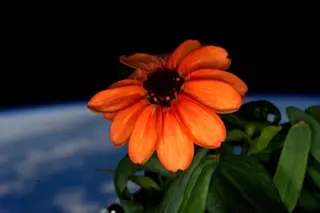An orange zinnia bloomed in zero gravity. (Credit: NASA/Scott Kelly) For people on solid ground back in the United States, spring is nothing more than pinprick of light at the end of a long, cold tunnel we call winter. But aboard the International Space Station, by all appearances, spring has sprung. Marathon U.S. astronaut Scott Kelly over the weekend tweeted images of the first flower to grow from a seed and subsequently bloom in space. The 13-petaled orange zinnia brought a little color to the otherwise aesthetically sterile surroundings on the ISS, and it was the first flower to show its glory in zero gravity. That’s one small step for Heliantheae, one giant leap for Plantae.
The path to orange splendor on the ISS wasn’t easy, and that’s what NASA scientists wanted. In May 2014, the Veggie plant growth facility was installed on the ISS, and crew members planted red ...














